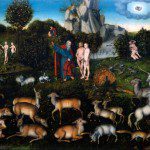I recently received, compliments of the publisher, a copy of a new book by Karl Giberson and Francis Collins The Language of Science and Faith: Straight Answers to Genuine Questions. This book has its origins in the avalanche of questions unleashed on Collins following the publication of his book The Language of God.
 From Giberson’s Acknowledgments:
From Giberson’s Acknowledgments:
Letters and emails poured in, asking for wisdom and insight. Readers wanted to dig deeper. Many had questions not addressed in The Language of God. Soon Francis was buried in a pile of “Frequently Asked Questions.” Addressing these questions individually was simply not possible, but many of them were passionate and came from people with real struggles. Ignoring them was not an option. (p. 11)
From this need was born both the BioLogos Foundation and this book. Dr. Collins founded BioLogos in 2007, worked with the foundation and on the book until he was nominated for and accepted the position as Director of NIH. As Director his efforts have moved to other endeavors and Dr. Giberson finished the book, but Dr. Collins remains interested in the dialog of science and faith. He will be one of the plenary speakers (along with Dr. John Polkinghorne) at the Christian Scholars’ Conference to be held at Pepperdine in June.
The Language of Science and Faith is not an encyclopedia of frequently asked questions – it is a readable book walking through many of the frequently asked questions in a narrative form. It is written for the nonscientist and will make a good resource for those with questions, for discussion groups, and for church leaders. I am not going to run through the entire book, but I will put up a few posts over the next several weeks using this book as a springboard to discuss some of the frequently asked questions.
What are the most important questions raised by modern science? What questions would you like to see addressed?
Distasteful Bedfellows. In the introduction to this book one objection to evolution, unrelated to either theology or science, is discussed. Evolution – biological change through mutation and natural selection – is associated with social Darwinism. Human efforts to shape civilization to benefit the strong and fit (us) by eliminating or sterilizing the less fit (them). If survival of the fittest is the ruling paradigm, then human selection becomes a moral mandate.
Oliver Wendell Holmes Jr. is quoted, in a decision about forced sterilization.
It is better for all the world, if instead of waiting to execute degenerate offspring for crime, or to let them starve for their imbecility, society can prevent those who are manifestly unfit from continuing their kind. (p. 25)
This line of reasoning makes several serious errors it (1) ascribes all traits to inheritance, (2) takes a factual claim about the past (natural selection) and (3) concludes that it is appropriate, morally requisite, to use artificial selection to shape the future. But all traits do not arise from inheritance. A complex mix of inheritance and environment is involved. This line of reasoning also makes a faulty connection between is and ought – because something is true doesn’t mean that it ought to be true.
And, if animals evolve by the strong destroying the weak – a caricature of evolution, by the way – should we then conclude that it is right for the strong to destroy the weak? (p. 26)
The appeal to science, to Darwinism, here is “nothing more than our unfortunate tendency to rationalize our selfish agendas.” That the facts of evolution can be misused and twisted to support atrocities on both large and small scales is unrelated to the truth of evolution. It speaks not to the science, but to fallen human nature.
The science of evolution needs to be considered on its own merits, not on the grounds of how it has been or may be misused.
The science. Chapter 1 addresses the scientific questions about evolution – what is evolution? what is the evidence for evolution? why do scientists accept the explanations of evolutionary biology? and what is the state of the field?
We can discuss evolution on two levels. The first most basic level is simply change through time. The evidence for evolution is embedded in the fossil record and there is no reasonable doubt that change has occurred through the ages. Life has evolved from simple to complex.
Evolution also refers to the mechanism of this change. The proposition is quite simple. (1) All life that exists on earth is descended from a common single cell ancestor that lived almost 4 billion years ago. (2) Changes occur gradually as a consequence of chemical changes in the genes. (3) Beneficial changes are preserved and deleterious mutations are eliminated (most changes are neither).
The evidence for evolution and common descent is immense – no observation in biology is inconsistent with this general scheme. How chemical changes occur, what kinds of changes occur, the rates of changes, the factors influencing the rates of changes, the factors contributing to classifying a change as beneficial, deleterious, or neither, the role of selection of individuals cs the role of group selection, and many more questions are being investigated and remain to be investigated. But the overall history and pattern is clear.
Note that does not deal with the origin of life; whether chemicals can combine to produce life is not part of the theory of evolution, although it is an interesting scientific question. It also does not say anything about whether the processes that drive it have purpose. Such questions are theological, not scientific. (p. 30)
Evolution is not a theory in trouble, on the contrary it is a theory with evidence accumulating steadily. Genome sequencing provides one of the most powerful threads of evidence. Everything is consistent with the general expectations of evolutionary theory for the diversification of life.
The chapter concludes with an interesting observation. An objection to evolution from the pages of scripture is the statement or command that everything reproduce after its kind. But this is true of evolutionary process. Every creature has reproduced after its kind, for almost four billion years. No fish gave birth to a lizard. No homo erectus gave birth to a homo sapiens. The changes are small, unobservable from generation to generation, but accumulate in populations.
The tiny difference that separate children from their parents rarely give us pause. Mary’s hair may be redder and Johnny’s longer than that of their parents, but who cares? … All that evolution requires is enough generations to accumulate the sort of tiny differences that separate offspring from their parents and almost any transformation can be achieved. (p. 52)
Evolution is happening today as it has in the past. And the past was no bloodier in tooth and claw than the present.
Evolution is not the only issue in the science and faith discussion – only the best known and most controversial. Later chapters in The Language of Science and Faith consider the relationship between science and religion, science and the existence of God, evolution and human beings, the grand narrative of creation, and more. I will dip into some of these in future posts.
What are the most important objections to the theory of evolution? Why is evolution troubling?
If you wish to contact me directly you may do so at [email protected]
If interested you can subscribe to a full text feed of my posts at Musings on Science and Theology.











